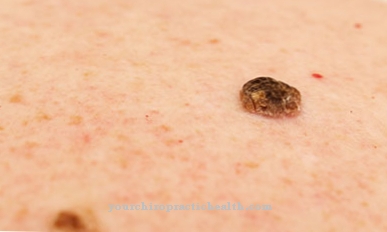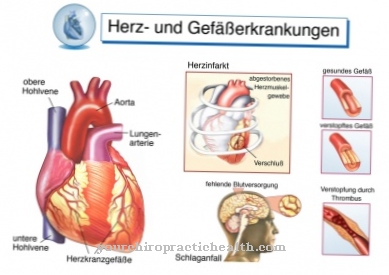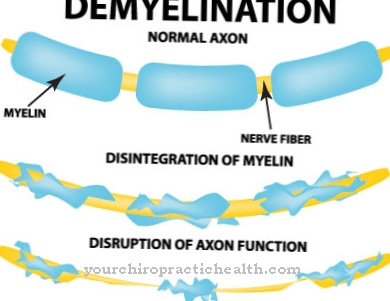The Cleft lip and palate is a relatively common malformation of the mouth. The medical term for it is Cheilognathopalatoschisis. The cleft lip and palate used to be colloquial Harelip called. Around 1500 children are born with this malformation in Germany every year.
What is a cleft lip and palate?
.jpg)
© Rungruedee - stock.adobe.com
If the facial parts of the embryo do not close completely during growth in the womb, visible malformations occur in the mouth area. Usually one arises on the left Cleft lip and palate.
The lips, jaw and palate are not completely closed at the same time. But there are also cleft lip and jaw, cleft lip and cleft palate. All types of crevices can also occur on both sides. The colloquial term harelip or wolf slit can hardly be heard today because it can be discriminatory.
Boys are more often affected than girls. Gap formation occurs in 1 in 500 births. The cleft lip and palate is one of the most common malformations.
causes
The cause of a Cleft lip and palate is not known. Medical professionals suspect that genetic factors are responsible, because 15 percent have further cases of cleft formation within the family. A special variant of hereditary traits can also be seen more frequently in people with a gap.
In addition to inheritance, other factors are also possible. It is possible that vitamin deficiencies, overdoses of vitamin A and vitamin E, lack of oxygen, smoking and alcohol can promote the formation of a cleft lip and palate.
The embryo develops its face during the first few weeks of the embryo. If there are negative influences during this time, the face may not fully develop. A cleft lip and palate can result. Cleft lips or jaws are caused by disorders in the 5th to 6th week of pregnancy. Cleft palates arise due to disorders in the 10th to 12th week of pregnancy.
Symptoms, ailments & signs
The cleft lip and palate can be recognized by the characteristic malformation of the mouth area. The lips, upper jaw, palate, mouth and nose show severe deformations, with the actual crevice usually only occurring on one side. The malformation causes various symptoms such as misalignment of the teeth, noses and language problems.
As a result of the malformation, affected children usually develop an unclear pronunciation and then mumble a lot, for example. In addition, the crevice causes problems with food intake, which can lead to deficiency symptoms. The crevice rarely develops within the oral cavity, which can result in problems with swallowing and ear infections, among other things.
The column can vary in size, shape and location. It occurs predominantly on the left side and can range from simple skin defects of the upper lip to serious deformities. The cleft lip and palate often occurs in conjunction with other malformations. This can contribute to the development of mental problems in those affected.
Many people with cleft lip and palate develop depression or social anxiety during their lifetime. The deformity itself is not life-threatening, but the emotional consequences can greatly reduce the quality of life. With early therapy, a large part of the deformities can be surgically removed.
Diagnosis & course
The diagnosis can be made easily on the basis of the typical appearance features. The Cleft lip and palate can be recognized at first glance in newborns. If the lips are not affected, the doctor must examine the baby's mouth to make a diagnosis.
From the 18th week of pregnancy, a cleft lip and palate can already be detected by an ultrasound examination.
Thanks to the very good surgical options, both aesthetic and functional results can be achieved. The course of a cleft lip and palate is very positive today, because the cleft can be completely closed. By promoting speech therapy, it is possible in 90 percent of all cases to bring about normalization.
Complications
As a result of the cleft lip and palate, most of those affected suffer from various malformations that significantly limit the everyday life of the person concerned and can significantly reduce the quality of life. As a rule, the malformations mainly affect the palate and the upper jaw. The lips can also be affected by this complaint, so that the absorption of liquids and food is restricted by this complaint.
Misalignments also occur on the patient's teeth and jaw, which can often lead to pain and further restrictions in everyday life. The mouth and nose are also deformed. Furthermore, the cleft lip and palate often leads to bullying or teasing in children and can thus also trigger psychological complaints or depression. In addition, most patients also suffer from speech disorders due to the cleft lip and palate and cannot easily communicate with other people.
A causal treatment of this disease is unfortunately not possible. Those affected are therefore dependent on various surgical interventions that can alleviate and limit the symptoms. There are usually no complications. The life expectancy of the patient is usually not reduced by this disease. It is not uncommon for the parents and relatives of those affected to suffer from the symptoms of cleft lip and palate.
When should you go to the doctor?
The cleft lip and palate is usually diagnosed by doctors, pediatric nurses or nurses who are present when the child is born. Since various obstetricians are present in the inpatient environment, they take over the further medical care of the newborn. It is therefore not necessary for the parents to initiate a visit to the doctor. If a home birth takes place, the first care of the child is taken over by the midwife present. She puts you in contact with a doctor in the event of irregularities and initiates the necessary steps for treatment.
If, in exceptional cases, a sudden birth takes place without the presence of nursing staff or under medical supervision, a doctor must be consulted immediately after the birth.It is advisable to call an ambulance service so that mother and child can be transported to a hospital as quickly as possible. The visual changes in the cleft lip and palate can be seen immediately when the child is born.
In order to avoid further complications, medical treatment should always be carried out immediately. In severe cases, the newborn's airways are compromised. In these situations, first aid measures must be taken. Since cleft lip and palate can already be diagnosed before birth, the expectant mother should take part in all check-ups offered during pregnancy.
Treatment & Therapy
Treatment of the Cleft lip and palate can drag on into adulthood. The first goal is to have normalized the child's appearance before starting school. In addition, speaking, chewing, listening and breathing should be normal.
Several doctors work together to treat cleft lip and palate: pediatricians, dentists, orthodontists, oral and maxillofacial surgeons, ENT doctors and speech therapists. In some cases, treatment by a psychotherapist is advisable.
The first treatment measures should be initiated in the first few days after the birth. In order to promote the direction of growth of the palate, the position of the tongue and the function of the tongue and to enable relatively normal drinking, the doctor first takes an impression of the jaw. A palate plate is made with it. This separates the nasal cavity from the mouth. Further malformations must be ruled out.
The doctor examines the heart and kidneys. The cleft lip and palate is surgically corrected with age. Speech therapy is important so that the child learns the right way to make sounds and to speak the language. Orthodontic measures are necessary in addition to proper dental care so that the teeth are set and properly formed. Psychological therapy helps the child and their parents to cope with the psychological stress.
The first surgical intervention takes place at the age of three to six months. The soft palate, upper jaw and lips are closed. The hard palate is corrected at 12 to 18 months of age. Further operations may then be necessary until adulthood. For example: nose corrections, teeth corrections, lip corrections and corrections to the soft palate.
Outlook & forecast
The malformation in the area of the mouth or the jaw can be treated well in most patients thanks to the medical possibilities. Nevertheless, the prognosis depends on the extent of the cleft palate and the start of treatment. If the birth takes place in an inpatient setting, a correction is initiated immediately after the birth process. In the event of a birth in a birthing center or in the home, the procedure can only be carried out with a time delay after being transported to the hospital. This often leads to the fact that the suture remains more visible in the further development and growth process of the child due to the time delay of the intervention.
Basically, the cleft lip and palate can now be treated so well that there is hardly any physical impairment of speech or the chewing process. Functional disorders are therefore not to be expected in the long term. Nevertheless, despite all efforts, an optical flaw remains due to the malformation due to the corrective intervention.
Follow-up treatments can be used which lead to an improvement. The strength of the abnormalities remains individual and can lead to a strong emotional burden. An unfavorable course of the illness leads to psychological complications. This fact must be taken into account when making the overall forecast. In addition, there is an increased risk of developing inflammations in the head area more frequently over the lifetime.
prevention
One Cleft lip and palate can only be prevented to a limited extent. However, the risk can be reduced by avoiding alcohol, cigarettes, oxygen deficiency, vitamin deficiency, malnutrition, vitamin E overdose and stress before and during pregnancy.
Aftercare
Due to the cleft lip and palate, those affected suffer various malformations that significantly limit their everyday lives and reduce their quality of life. As a result, those affected suffer from their external appearance. In most cases, the condition is treated surgically in early childhood. Aftercare in the true sense of the word is largely omitted, provided that there are no further physical symptoms.
Rather, it is about permanently promoting a self-confident handling of the disease. In more severe cases, the help of a professional psychologist can be supportive. This can sometimes also prevent the development of severe depression and other mental illnesses and rather ensure that you live well with the restriction.
You can do that yourself
In the case of cleft lip and palate, a lifelong cosmetic blemish often remains despite good and quick medical care. The health impairments can be cured and remedied very well through medical progress. Nevertheless, many sufferers suffer from the permanent visual change.
Men can often help themselves in everyday life by using their beard growth to cover up the irregularity. Depending on the individual circumstances, the abnormality can be covered almost completely. People bystanders do not notice any difference to other people and unpleasant looks or phrases are avoided. In girls and women, there is an opportunity to achieve relief from the seam on the lip with cosmetic products.
Since the visual changes in a cleft palate still do not completely disappear with this method, it is helpful to show confident handling. Relaxation techniques can be used to strengthen mental strength. These lead to a reduction in internal stressors and strengthen vitality. Through yoga or meditation, the focus of perception is placed on other areas of life and on one's own strengths. Many of those affected also find it helpful to exchange ideas with other sufferers. Experiences and experiences are discussed with one another. In addition, helpful tips for dealing with the complaints in everyday life can be given.













.jpg)

.jpg)
.jpg)











.jpg)